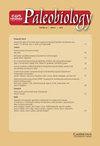Latest Maastrichtian middle- and high-latitude mosasaurs and fish isotopic composition: carbon source, thermoregulation strategy, and thermal latitudinal gradient
IF 2.6
2区 地球科学
Q2 BIODIVERSITY CONSERVATION
引用次数: 2
Abstract
Abstract. Here we report high-latitude stable isotope compositions of Maastrichtian fossil fish and marine reptiles (mainly mosasaurs) from Antarctica (64°S paleolatitude) and compare them with mid-paleolatitude samples from Argentine Patagonia (45°S). Disparities between the δ13C values of bony fish and marine reptiles correspond to differences in the foraging ground (distance from the shore and depth), while dramatically higher δ13C values (by 18‰) in shark enameloid cannot be explained through ecology and are here imputed to biomineralization. Comparison with extant vertebrates suggests that the diet alone can explain the offset observed between bony fish and mosasaurs; however, breath holding due to a diving behavior in mosasaurs may have had some impact on their δ13C values, as previously suggested. The δ18OPO4 values of the remains confirm a relatively stable, elevated body temperature for marine reptiles, meaning that they were thermoregulators. We calculated a water temperature of ∼8°C for Antarctica from the fish δ18OPO4 values, warmer than present-day temperatures and consistent with the absence of polar ice sheets during the latest Maastrichtian. Our fish data greatly extend the latitudinal range of Late Cretaceous fish δ18OPO4 values and result in a thermal gradient of 0.4°C/1° of latitude when combined with literature data.最新马斯特里赫特中高纬度摩萨龙和鱼类同位素组成:碳源、温度调节策略和热纬度梯度
摘要在这里,我们报道了南极(古纬度64°S)马斯特里赫特阶鱼类和海洋爬行动物化石(主要是摩萨龙)的高纬度稳定同位素组成,并将其与阿根廷巴塔哥尼亚(古纬度45°S)的中纬度样本进行了比较。硬骨鱼和海洋爬行动物的δ13C值之间的差异对应于觅食地(距离海岸和深度)的差异,而鲨鱼搪瓷中的δ13C值显著更高(18‰)无法通过生态学来解释,在这里被归咎于生物矿化。与现存脊椎动物的比较表明,仅靠饮食可以解释硬骨鱼和摩萨龙之间观察到的偏移;然而,正如之前所暗示的,摩萨龙潜水行为导致的屏气可能对其δ13C值产生了一些影响。遗骸的δ18OPO4值证实了海洋爬行动物相对稳定、体温升高,这意味着它们是体温调节器。我们根据鱼类的δ18OPO4值计算出南极洲的水温为~8°C,比现在的温度高,与最近马斯特里赫特阶没有极地冰盖的情况一致。我们的鱼类数据极大地扩展了晚白垩世鱼类δ18OPO4值的纬度范围,并与文献数据相结合,产生了0.4°C/1°纬度的热梯度。
本文章由计算机程序翻译,如有差异,请以英文原文为准。
求助全文
约1分钟内获得全文
求助全文
来源期刊

Paleobiology
地学-古生物学
CiteScore
5.30
自引率
3.70%
发文量
38
审稿时长
>12 weeks
期刊介绍:
Paleobiology publishes original contributions of any length (but normally 10-50 manuscript pages) dealing with any aspect of biological paleontology. Emphasis is placed on biological or paleobiological processes and patterns, including macroevolution, extinction, diversification, speciation, functional morphology, bio-geography, phylogeny, paleoecology, molecular paleontology, taphonomy, natural selection and patterns of variation, abundance, and distribution in space and time, among others. Taxonomic papers are welcome if they have significant and broad applications. Papers concerning research on recent organisms and systems are appropriate if they are of particular interest to paleontologists. Papers should typically interest readers from more than one specialty. Proposals for symposium volumes should be discussed in advance with the editors.
 求助内容:
求助内容: 应助结果提醒方式:
应助结果提醒方式:


